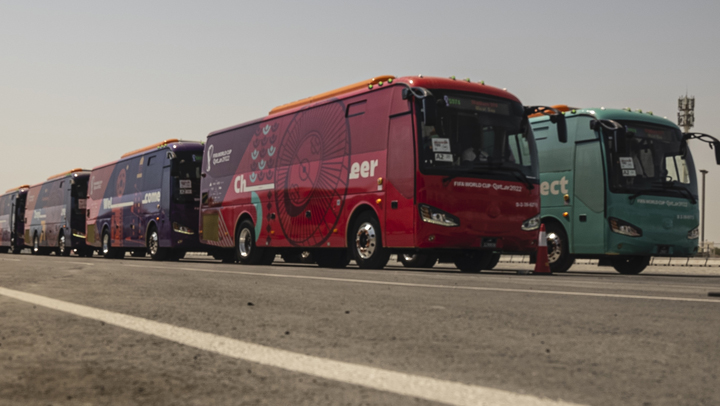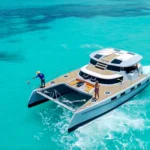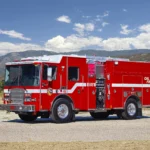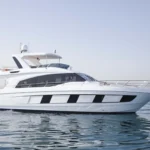
Buses are seen during a test run of massive bus fleet ahead of Qatar World Cup, in Doha, Qatar, Thursday, Sept. 22, 2022. Thani Al Zarraa, who is overseeing transport preparations, said some 4,000 buses will be used during the tournament, which around 700 will be electric. (AP Photo/ Lujain Jo)
Buses are an essential means of transportation that has been used for ages to transport people and commodities. They have become an essential part of our everyday life, assisting us in commuting to work, school, and other locations. Buses come in a variety of forms and sizes, ranging from small shuttle buses to massive articulated buses capable of transporting hundreds of passengers at once. We will discuss the intriguing history of buses, their numerous varieties, and their influence on society in this discussion. So let’s get started and learn more about these important cars!
The world’s first motorized bus was built in 1895 in Germany by Karl Benz, who is also credited with inventing the first gasoline-powered automobile.
The double-decker bus was invented in 1827 in England as a way to transport more passengers in a limited amount of space, and it quickly became an iconic symbol of London.
The first public bus service in the United States began operating in 1827 in New York City, using horse-drawn carriages to transport passengers.
The world’s longest bus route is the Trans-Siberian Express, which travels over 6,800 miles from Moscow to Vladivostok, and takes approximately 7 days to complete.
The first electric bus was introduced in 1882 in France, using a battery-powered motor to propel the vehicle.
The world’s largest bus is the AutoTram Extra Grand, which is over 98 feet long and can carry up to 256 passengers, and it is currently in use in Germany.
The first school bus was introduced in 1915 in the United States, as a way to transport children safely to and from school.
The word “bus” is short for “omnibus,” which means “for all” in Latin, reflecting the idea that buses are public transportation available to anyone.
The oldest operating bus route in the world is Route 24A in Kolkata, India, which has been in continuous operation since 1920, and is still in use today.
The first air-conditioned bus was introduced in 1939 in the United States, providing a more comfortable ride for passengers in hot and humid weather.
The London Routemaster bus, which was in service from 1956 to 2005, is considered an icon of British design, and is still used for special occasions and tourist attractions.
The first hydrogen fuel cell bus was introduced in 2004 in Reykjavik, Iceland, using hydrogen as a clean and renewable fuel source to power the vehicle.
The world’s fastest bus is the “Speedy Gonzales” bus, which set a world record in 1961 for reaching a speed of 180 miles per hour, using a jet engine to propel the vehicle.
The first articulated bus, which has a joint in the middle to allow for greater passenger capacity, was introduced in Switzerland in 1941, and is now commonly used in many countries around the world.
The first wheelchair-accessible bus was introduced in 1947 in the United States, as a way to provide equal access to public transportation for people with disabilities.
The world’s first hybrid bus was introduced in 1997 in the United Kingdom, using both an electric motor and a gasoline engine to improve fuel efficiency and reduce emissions.
The first bus rapid transit system, which is a high-speed bus system with dedicated lanes and stations, was introduced in Curitiba, Brazil in 1974, and has since been adopted in many cities around the world.
The world’s first driverless bus service was introduced in 2016 in Lyon, France, using sensors and artificial intelligence to safely and efficiently transport passengers without a driver.
The first “party bus,” which is a bus designed for entertainment and social gatherings, was introduced in the 1970s in the United States, and has since become a popular mode of transportation for events such as weddings and proms.
The first bus with a restroom was introduced in 1946 in the United States, providing a more comfortable and convenient travel experience for passengers on long-distance trips.
The longest bus in production today is the 101-feet-long bi-articulated Van Hool AGG300, which is used in a number of cities across the world, including Mexico City and Helsinki.
In many developing countries, buses are often used not just for transportation of people, but also for goods and livestock, with buses being converted into makeshift trucks.
The term “chicken bus” is often used in Central America to refer to old American school buses that have been converted into public transportation, and are known for being crowded and uncomfortable.
Buses have been used in many movies and TV shows over the years, including “Speed,” “The Partridge Family,” and “The Magic School Bus.”
The first “art bus” was created in 1993 in Washington D.C., as a way to bring art to the community and to promote public transportation. The project has since been replicated in other cities across the world, including London and Sydney.









